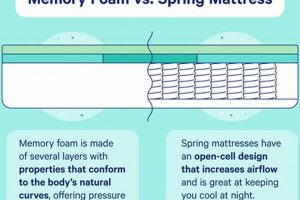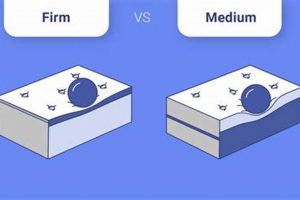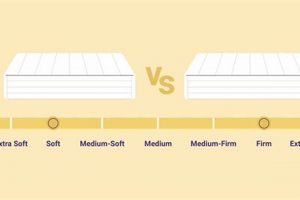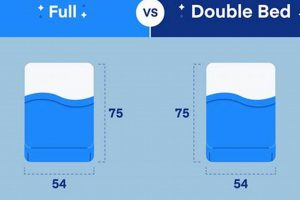The comparison involves two distinct methods of providing supplemental warmth to bedding. One is a textile covering designed to be placed on top of the sleeper, while the other is a pad situated beneath the sleeper, directly on the mattress. Both utilize electrical resistance to generate heat, offering a means to regulate sleeping temperature.
These devices address the challenge of maintaining a comfortable sleep environment, particularly in colder climates or for individuals sensitive to temperature fluctuations. Historically, solutions involved layering heavy blankets or using hot water bottles. Electrically heated options offer a more consistent and controllable heat source, promoting better sleep quality and potentially reducing energy consumption compared to heating an entire room.
This discussion will explore the key differences, advantages, and disadvantages of each option, focusing on factors such as safety features, heat distribution, ease of use, and maintenance, ultimately enabling informed purchasing decisions.
Usage Considerations
Effective use of electrically heated bedding necessitates adherence to safety guidelines and consideration of personal needs.
Tip 1: Prioritize Safety Certifications: Ensure the chosen product carries certifications from recognized testing laboratories. Certifications indicate adherence to safety standards and mitigate the risk of electrical hazards.
Tip 2: Regulate Temperature Settings: Avoid prolonged use at maximum heat. Moderate temperature settings prevent overheating and potential skin irritation. Utilize timer functions, if available, to automatically shut off the device after a predetermined period.
Tip 3: Inspect Regularly for Wear and Tear: Periodically examine the item for frayed cords, damaged connectors, or uneven heating patterns. Discontinue use immediately if any damage is detected.
Tip 4: Adhere to Washing Instructions: Follow the manufacturer’s washing instructions meticulously. Improper washing can damage the internal wiring and compromise the device’s safety and functionality.
Tip 5: Consider Individual Health Conditions: Individuals with certain medical conditions, such as diabetes or neuropathy, may experience reduced sensation and should exercise caution. Consult a healthcare professional before using electrically heated bedding.
Tip 6: Understand Layering Effects: Be mindful of the impact of additional bedding layers. Excessive layers can trap heat and potentially lead to overheating, requiring careful adjustment of the temperature setting.
Tip 7: Match to Bed Size: Select a product size appropriate for the mattress. Overhang or bunching can lead to uneven heating and potential damage to the device.
Adhering to these guidelines promotes safe and efficient operation, maximizing the benefits of controlled temperature regulation during sleep.
The subsequent sections will delve into specific product features and provide comparative analyses to further aid in the selection process.
1. Heat Distribution
Heat distribution is a primary differentiator between a heated throw and a heated mattress pad, influencing overall user comfort and perceived warmth. The location of the heating element relative to the sleeper is a key determinant of heat delivery patterns. A pad, situated directly beneath the body, provides a consistent, enveloping warmth that emanates from below. This upward heat transfer minimizes heat loss and creates a more uniform temperature across the sleeping surface. In contrast, the textile covering, placed on top, delivers heat primarily to the area it directly covers. This can result in localized warmth with potential temperature variations across the bed.
Uneven heat distribution can negate the benefits of supplemental warmth, leading to discomfort and interrupted sleep. For example, a heated throw that is not adequately sized for the bed may leave extremities cold, while the torso remains warm. Similarly, bunching or folding of the textile can create hot spots, increasing the risk of overheating in localized areas. The mattress pad mitigates these issues by distributing heat more evenly across the entire sleeping surface, creating a stable thermal environment. This evenness is particularly important for couples with differing temperature preferences, as each side of the pad can be independently controlled in some models.
Ultimately, the choice between a heated throw and a heated mattress pad hinges on individual preferences regarding heat distribution. The mattress pads consistent, enveloping warmth may be preferable for those seeking uniform temperature regulation, whereas the localized warmth of the throw may be more suitable for individuals targeting specific body areas. Understanding these heat distribution characteristics is crucial for selecting the appropriate electrically heated bedding product to optimize sleep comfort and satisfaction.
2. Placement & Comfort
Placement significantly affects the comfort experienced when using either a heated throw or a heated mattress pad. A throw’s placement on top of the bedding allows for flexible application; it can be used to target specific areas, such as the feet or torso. However, this placement can also result in uneven distribution of warmth, potentially leading to localized overheating or cold spots if the textile shifts during sleep. Furthermore, the bulk of the heated throw, especially in models with thicker heating elements, can impact sleep comfort by creating pressure points or restricting movement. The pad’s location beneath the fitted sheet offers a more integrated sleeping experience. The uniform distribution of weight across the pad minimizes the potential for pressure points. The pad’s placement ensures consistent warmth throughout the night.
The choice between the two options hinges on individual comfort preferences and sleep habits. For example, someone who tosses and turns frequently might find that a pad offers a more stable and consistent temperature environment compared to a throw that shifts with movement. Conversely, an individual who only requires warmth in a specific area of the body may prefer the targeted heat delivery of a throw. The material and construction of each product also play a role in comfort. Throws are often made of plush materials like fleece or microfiber, prioritizing softness against the skin. Mattress pads, on the other hand, focus on durability and even heat distribution, often utilizing quilted designs and secure attachment systems to prevent shifting.
Ultimately, understanding the interplay between placement and comfort is essential when selecting the appropriate device. Individuals should consider their sleep style, temperature preferences, and any potential sensitivities to pressure or uneven heating when making their decision. Careful consideration of these factors ensures a more comfortable and restful sleep experience, maximizing the benefits of electrically heated bedding.
3. Safety Features
Safety features are paramount when evaluating the utility and appropriateness of electrically heated bedding. The potential for electrical malfunction necessitates robust safety mechanisms in both heated throws and pads. Overheating protection, a critical component, typically involves a thermostat that automatically shuts off the device if it reaches an unsafe temperature. This prevents burns and reduces the risk of fire. Absence of such a feature significantly elevates the risk associated with using these products. For instance, a defective heating element lacking overheat protection could continuously increase in temperature, causing fabric to ignite and potentially resulting in a house fire. Modern products often incorporate multiple levels of safety, including backup thermostats and fuses, to provide redundancy and enhance reliability.
Another important safety consideration is the integrity of the wiring and insulation. Damaged or frayed cords pose a significant electrocution hazard. Products with reinforced cords and durable insulation minimize this risk. Furthermore, automatic shut-off timers are frequently included to limit the duration of use, preventing overheating during sleep and conserving energy. Independent testing and certification from recognized safety organizations, such as UL or ETL, provide assurance that a product meets established safety standards. For example, a product bearing the UL mark has undergone rigorous testing to verify its electrical safety and performance characteristics. Consumers should prioritize products with these certifications to minimize potential hazards.
In conclusion, safety features represent a critical factor in the decision-making process when selecting electrically heated bedding. The presence of robust safety mechanisms, such as overheat protection, reinforced wiring, and independent certifications, significantly reduces the risks associated with using these products. Consumers should prioritize safety certifications to mitigate potential hazards and ensure a safe and comfortable sleep environment. Disregarding safety features can have severe consequences, underscoring the importance of thorough product evaluation prior to purchase and use.
4. Maintenance Needs
The divergence in maintenance requirements between heated throws and heated mattress pads arises primarily from their construction and usage patterns. Heated throws, often composed of plush fabrics, are typically subjected to more frequent washing due to their direct contact with skin and potential exposure to spills. Repeated washing, however, can degrade the integrity of the internal wiring and heating elements, shortening the lifespan of the device. Conversely, mattress pads, shielded by a fitted sheet, require less frequent cleaning. Their location minimizes direct contact with contaminants, reducing the need for aggressive washing procedures. Consequently, the structural integrity of the heating elements within a mattress pad tends to be better preserved over time.
Proper maintenance is crucial for ensuring both the longevity and safety of these electrically heated products. Adherence to manufacturer-specified washing instructions is paramount. Overly aggressive washing cycles or the use of harsh detergents can damage the internal wiring, leading to malfunctions and potential electrical hazards. Spot cleaning of minor stains on throws can mitigate the need for frequent full washes. Similarly, regular vacuuming of the mattress and pad can remove dust and debris, preventing the buildup of allergens and maintaining hygiene. Storage practices also play a significant role. When not in use, both heated throws and pads should be stored carefully to avoid creasing or folding the internal wires, as this can lead to damage and uneven heating. For instance, rolling the product instead of folding it minimizes stress on the wiring.
In summary, the maintenance needs of electrically heated bedding products significantly impact their lifespan and safety. Heated throws generally require more frequent, yet gentler, cleaning compared to mattress pads. Strict adherence to manufacturer instructions and careful storage practices are essential for maximizing product longevity and mitigating potential electrical hazards. Understanding these maintenance requirements allows consumers to make informed decisions about product selection and usage, ensuring both comfort and safety.
5. Energy Efficiency
Energy efficiency represents a critical consideration when evaluating electrically heated bedding. The operating cost and environmental impact are directly influenced by the power consumption of these devices. Efficient utilization of energy translates to reduced electricity bills and a smaller carbon footprint. Both types of devices offer a more targeted heating solution compared to warming an entire room, but their energy efficiency characteristics can differ.
- Wattage Consumption
Wattage consumption serves as a primary indicator of energy usage. Lower wattage equates to lower energy consumption and reduced operating costs. For instance, a heated mattress pad with a wattage rating of 100W will consume less electricity per hour compared to a heated throw rated at 150W, assuming both are used at the same settings. This difference becomes significant over prolonged periods of use, particularly during colder months when supplemental heating is frequently required.
- Zonal Heating Capabilities
Zonal heating allows for independent temperature control in different areas of the device, optimizing energy usage by only heating the sections that require it. Certain electrically heated mattress pads offer dual-zone controls, enabling customized heating for individual sleepers on each side of the bed. This localized heating minimizes wasted energy by preventing the unnecessary warming of unoccupied areas. A heated throw offers similar zonal control by allowing the user to target specific body parts, such as the feet or torso, rather than heating the entire bed.
- Insulation and Heat Retention
The insulating properties of the materials used in both heated throws and pads influence their ability to retain heat and minimize energy loss. Thicker, more densely woven fabrics provide better insulation, reducing the need for the device to continuously generate heat to maintain a desired temperature. For example, a heated throw made from a high-quality fleece material will generally retain heat more effectively than one made from a thinner, less insulating fabric. Similarly, a mattress pad with a quilted design and a thermal reflective layer will minimize heat loss into the mattress, improving energy efficiency.
- Timer and Automatic Shut-Off Features
Timer and automatic shut-off features contribute significantly to energy conservation by preventing the device from operating unnecessarily. A timer allows the user to set a specific duration for operation, automatically turning off the device after the allotted time has elapsed. This prevents the device from running all night, even after the sleeper has fallen asleep and no longer requires supplemental heat. An automatic shut-off feature typically activates after a predetermined period, such as 10 hours, providing an additional layer of safety and energy conservation. For instance, a heated mattress pad with a 10-hour automatic shut-off will cease operation even if the timer is not set, preventing energy wastage and mitigating potential overheating risks.
In conclusion, energy efficiency is a multifaceted consideration when evaluating the “electric blanket vs electric mattress pad” choice. Factors such as wattage consumption, zonal heating capabilities, insulation properties, and timer/automatic shut-off features all contribute to the overall energy performance of these devices. Selecting a product with efficient design and features can result in significant energy savings over time, reducing both operating costs and environmental impact.
Frequently Asked Questions
This section addresses common inquiries and concerns regarding the selection and use of electrically heated bedding, including heated throws and pads. It aims to provide clear and concise answers based on available information.
Question 1: Is one option inherently safer than the other?
Both heated throws and heated mattress pads present potential safety hazards if misused or if defective. Ensuring the chosen product adheres to recognized safety standards, such as UL or ETL certification, is paramount. Regular inspection for wear and tear, particularly of the power cord, is essential for both types of devices. The presence of automatic shut-off features and overheat protection mechanisms are critical for mitigating risks.
Question 2: Does placement affect the device’s lifespan?
Yes, placement and subsequent care routines influence longevity. Mattress pads, shielded by a fitted sheet, typically require less frequent washing compared to throws, reducing stress on the internal wiring. Proper storage practices, such as rolling rather than folding the device, minimize stress on the internal components and contribute to extended lifespan for both product types.
Question 3: Are there specific health conditions that contraindicate the use of electrically heated bedding?
Individuals with certain medical conditions, such as diabetes, neuropathy, or peripheral vascular disease, may experience reduced sensation and impaired ability to detect excessive heat. This can increase the risk of burns. Consultation with a healthcare professional is advised prior to using these products if such conditions are present.
Question 4: How do heating elements affect the comfort level?
Thick or unevenly distributed heating elements can create pressure points and reduce sleep comfort. Products with thin, evenly spaced wiring are preferable. Consider materials and construction that prioritize comfort, such as plush fabrics for throws and quilted designs for mattress pads, to minimize any adverse impact on sleep quality.
Question 5: Can these items be used on adjustable beds?
Specific products designed for use on adjustable beds are available. Standard electrically heated bedding may not be suitable due to potential damage to the internal wiring caused by the flexing motion of the adjustable frame. Refer to the manufacturer’s instructions to ensure compatibility and avoid compromising safety or product lifespan.
Question 6: What is the typical warranty period for electrically heated bedding?
Warranty periods vary depending on the manufacturer and product. A typical warranty might range from one to five years. Reviewing the warranty terms carefully is advisable prior to purchase, paying close attention to coverage details and any limitations or exclusions.
Careful consideration of these frequently asked questions empowers consumers to make informed decisions, prioritizing safety, comfort, and product longevity when selecting and utilizing electrically heated bedding.
The subsequent section will provide a comparative summary to facilitate a clear understanding of the key differences and advantages of each option.
electric blanket vs electric mattress pad
This exploration of “electric blanket vs electric mattress pad” has highlighted crucial distinctions in heat distribution, comfort, safety, maintenance, and energy efficiency. The mattress pad provides consistent, enveloping warmth, while the textile covering offers targeted heat. Rigorous adherence to safety standards and meticulous maintenance are paramount for both options. Ultimately, the optimal choice hinges on individual needs and preferences.
Selecting the appropriate electrically heated bedding represents a significant investment in sleep quality and well-being. Consumers are encouraged to carefully weigh the factors presented herein to make an informed decision that aligns with their specific requirements, thereby ensuring a safe and comfortable sleep environment for years to come. Prioritizing safety certifications and adhering to usage guidelines remains of utmost importance.


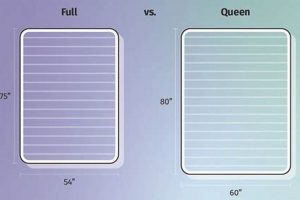
![Saatva vs Leesa Mattress: Which Bed Wins? [2024] Organic & Natural Mattress Buyer’s Guide: Non-Toxic Sleep Solutions Saatva vs Leesa Mattress: Which Bed Wins? [2024] | Organic & Natural Mattress Buyer’s Guide: Non-Toxic Sleep Solutions](https://mattressworldpa.com/wp-content/uploads/2025/07/th-1084-300x200.jpg)
